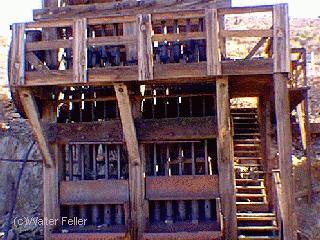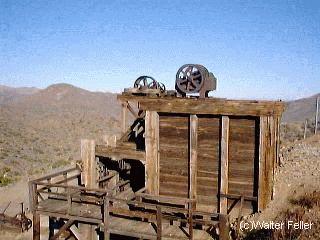--
Joshua Tree National Park
The Lost Horse Mine
The Lost Horse Mine is one of the most famous and productive gold and silver mines located in what is now Joshua Tree National Park, California. Its history is a significant part of the cultural and mining heritage of the area, illustrating the rugged determination of the prospectors and miners who ventured into the desert in search of wealth during the late 19th and early 20th centuries.The mine was discovered in the 1890s by a cowboy named Johnny Lang and his father-in-law, following the theft of their horses by Native Americans. According to legend, while tracking the stolen horses, they stumbled upon a rock outcrop that showed signs of gold. Realizing the potential value of their find, they staked a claim and named it Lost Horse.
To protect his mine from claim jumpers and to ensure it was worked properly, Lang brought in a partner, a more experienced miner named J.D. Ryan. Ryan introduced more efficient mining methods and machinery, including a steam-powered two-stamp mill to crush the ore and extract the gold and silver. Under Ryan's management, the Lost Horse Mine became one of the most productive mines in the area, reportedly producing more than $5 million in gold and silver during its operation, which was an enormous sum at the time.
The mine operated successfully for several years, but like many others, it began to decline in productivity by the early 20th century. The best veins were exhausted, and lower gold prices made operations less profitable. By the 1930s, the Lost Horse Mine was abandoned, leaving behind a ghost of its former bustling activity.
Today, the Lost Horse Mine is part of Joshua Tree National Park and is preserved as a historic site. Visitors can hike to the mine's location, where the remains of the mill and several buildings stand as a testament to the area's rich mining history. The National Park Service has worked to stabilize the ruins, ensuring that they remain a tangible connection to the past for future generations to learn from and enjoy.
The story of the Lost Horse Mine encapsulates the boom-and-bust cycle typical of the mining industry in the American West. It serves as a reminder of the harsh conditions faced by those who sought their fortunes in the desert and the impact of mining on the development of the region.
-
Johnny Lang & the Lost Horse Mine
Some people and places become inextricably linked in history. One wouldn't be quite what it was without the other. In this case, the Lost Horse Mine may have been ...How does a Stamp Mill work?
A stamp mill was a mechanical crusher, noisy, heavy and somewhat awkward to operate. The stamps were heavy metal weights that were ...


